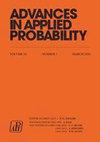An asymptotically optimal heuristic for general nonstationary finite-horizon restless multi-armed, multi-action bandits: Corrigendum
IF 1.2
4区 数学
Q3 STATISTICS & PROBABILITY
引用次数: 0
Abstract
The above lemma is used to prove Theorems 1–2 and Propositions 1–3 in Sections 4 and 6 of [1]. It has been graciously pointed out to us that the bound in the lemma may not be correct in general. The original proof of this lemma uses a combination of linear program (LP) duality and sensitivity analysis results. The mistake is in the application of a known sensitivity analysis result under a certain assumption that happens to be not necessarily satisfied by our LP. Fortunately, it is possible to correct the bound in the above lemma. The new bound that we will prove in this correction note is as follows:一般非平稳有限域不安多武装多行动土匪的渐近最优启发式算法:勘误表
上述引理用于证明[1]第4节和第6节中的定理1 - 2和命题1 - 3。有人慷慨地向我们指出,引理中的界通常可能是不正确的。该引理的原始证明使用了线性规划对偶和灵敏度分析结果的组合。错误在于在一定的假设下应用已知的灵敏度分析结果,而我们的LP不一定满足。幸运的是,上面引理中的界是可以修正的。我们将在这个更正注中证明的新界如下:
本文章由计算机程序翻译,如有差异,请以英文原文为准。
求助全文
约1分钟内获得全文
求助全文
来源期刊

Advances in Applied Probability
数学-统计学与概率论
CiteScore
2.00
自引率
0.00%
发文量
64
审稿时长
6-12 weeks
期刊介绍:
The Advances in Applied Probability has been published by the Applied Probability Trust for over four decades, and is a companion publication to the Journal of Applied Probability. It contains mathematical and scientific papers of interest to applied probabilists, with emphasis on applications in a broad spectrum of disciplines, including the biosciences, operations research, telecommunications, computer science, engineering, epidemiology, financial mathematics, the physical and social sciences, and any field where stochastic modeling is used.
A submission to Applied Probability represents a submission that may, at the Editor-in-Chief’s discretion, appear in either the Journal of Applied Probability or the Advances in Applied Probability. Typically, shorter papers appear in the Journal, with longer contributions appearing in the Advances.
 求助内容:
求助内容: 应助结果提醒方式:
应助结果提醒方式:


